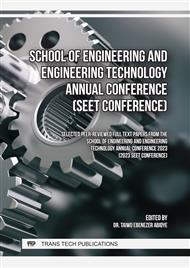[1]
Gautam, B. R. (2018). Bacteria Based Self-Healing Concrete – A Bacterial Approach. The International Journal of Engineering and Science, 57-61.
Google Scholar
[2]
Akingbonmire, S. L. (2018). Evaluation of the Compressive Strength of Concrete Prepared with Water Selected from Different Sources in Akure. Proceedings of the 2018 Annual Conference of the School of Engineering and Engineering Technology (SEET), The Federal University of Technology, Akure, Nigeria, 17 – 19 July, 2018.
DOI: 10.24867/jpe-2018-02-043
Google Scholar
[3]
Mostafa, S., Ali, K.S., and Aydin, B. (2016). Bio concrete: next generation of self-healing concrete. School of Engineering, Faculty of Science and Engineering, The University of Waikato, Hamilton, New Zealand.
Google Scholar
[4]
Mohamed, H. F. (2016). Effectiveness of Self-Healing in Repair of Strategic Concrete Structures "A Simplified Model" (Master's thesis). School of Sciences and Engineering, American University in Cairo, Cairo, Egypt.
Google Scholar
[5]
Alshalif, A.F., Irwan, J.M., Tajarudin, H.A., Othman, N., Al-Gheethi, A.A., Shamsudin, S., Altowayti, W.A.H., Abo Sabah, S. (2021). Optimization of Bio-Foamed Concrete Brick Strength via Bacteria Based Self-Healing and Bio-Sequestration of CO2. Materials, 14, 4575.
DOI: 10.3390/ma14164575
Google Scholar
[6]
Lee, H.X.D, Wong, H. S. and Buenfeld, N. R. (2015). Self-Sealing of Cracks in Concrete using Super Absorbent Polymers. Cement and Concrete Research, 79, 194 – 208.
DOI: 10.1016/j.cemconres.2015.09.008
Google Scholar
[7]
Ismael, J., Andrew, H., Susanne, G., and Kevin, P. (2021). Aerobic non-ureolytic bacteria-based self-healing cementitious composites: A comprehensive review. Journal of Building Engineering, 42, 102834.
DOI: 10.1016/j.jobe.2021.102834
Google Scholar
[8]
Cuenca, E. and Ferrara, L. (2017). Self-healing Capacity of Fiber Reinforced Cementitious Composites. State of the Art and Perspectives. Journal of Civil Engineering (0000)00(0):1-13.
DOI: 10.1007/s12205-017-0939-5
Google Scholar
[9]
Rajczakowski, M. (2019). Self-healing Concrete, Thesis for the Degree of Licentiate (Tech. Lic) in Building Materials, Department of Civil, Environmental and Natural Resources Engineering, Luleå University of Technology SE-97187 Luleå, Sweden.
Google Scholar
[10]
Heidari, R., & Niknahad, H. (2019). The role and study of mitochondrial impairment and oxidative stress in cholestasis.Experimental cholestasis research, 117-132.
DOI: 10.1007/978-1-4939-9420-5_8
Google Scholar
[11]
Sini, B. (2016). Self-healing bacterial cementitious concrete: development and performance evaluation (Doctor's Dissertation). Ryerson University, Toronto, Canada.
Google Scholar
[12]
Barbosa, B., Paidhungat, M., and Setlow, P. (2005). Effects of a gerF (lgt) mutation on the germination of spores of Bacillus subtilis. Journal of Bacteriology. 186(10), 2984–2991.
DOI: 10.1128/jb.186.10.2984-2991.2004
Google Scholar
[13]
British Standards Institution. (1983). BS 1881: Part 122:1983 Testing concrete: Method for determination of water absorption. Retrieved from https://www.en-standard.eu/bs-1881-122-2011-a1-2020-testing-concrete-method-for-determination-of-water-absorption/
DOI: 10.3403/00049286
Google Scholar
[14]
ASTM International. (n.d.). Standard test method for measurement of rate of absorption of water by hydraulic-cement concretes (ASTM C 1985). Retrieved from https://www.astm.org/ c1585-20.html
Google Scholar
[15]
ASTM International. (2018). Standard Test Method for Sieve Analysis of Fine and Coarse Aggregates (ASTM C 136). Retrieved from https://www.astm.org/c0136_c0136m-19.html
Google Scholar
[16]
CivilSir. (2021). What is the slump in concrete | Concrete slump test. Retrieved May 15, 2023, from https://civilsir.com/what-is-the-slump-in-concrete-concrete-slump-test/.
DOI: 10.3403/02129930
Google Scholar
[17]
British Standards Institution. (1992). BS 882:1992 Specification for aggregates from natural sources for concrete. Retrieved from https://knowledge.bsigroup.com/products/specification-for-aggregates-from-natural-sources-for-concrete-1/standard
DOI: 10.3403/00047290u
Google Scholar


